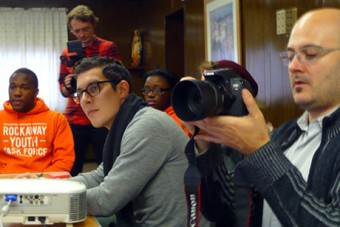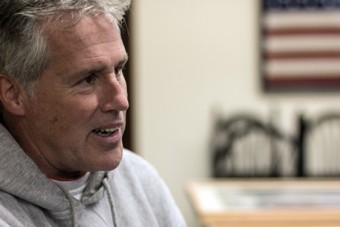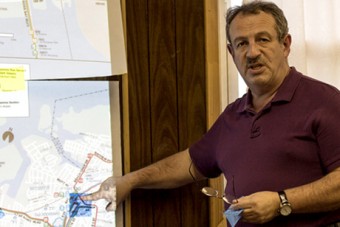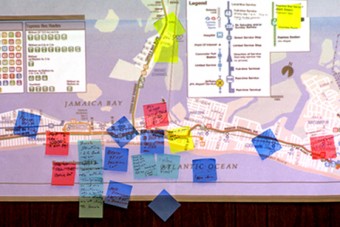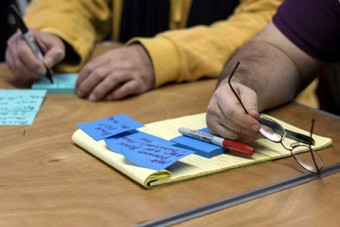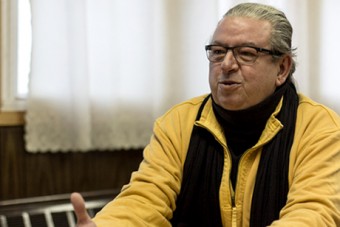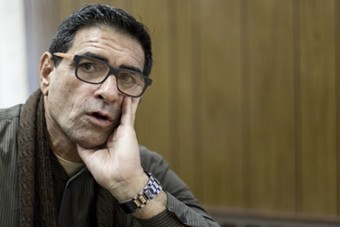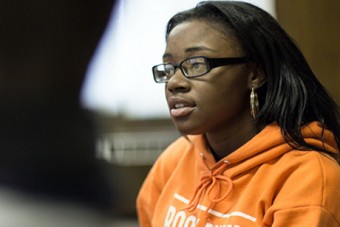Design/Relief
Rockaways
Posted By:
Admin
Saturday 11 January 2014
KNIGHTS OF COLUMBUS MEETING at B90th Street, DECEMBER 4, 2013
All Photos: Carolyn Louth and Daniel Latorre
Knights of Columbus Rockaway Council kindly provided a meeting space for TeamRock to host its first community roundtable, and we made our way to their hall’s second floor on a wintry, Wednesday afternoon in December. Once gathered in a cozy den of wood paneling, friendly introductions were followed by community engagement strategist Daniel Latorre’s reassurance that this would be no ordinary, boring meeting but a “visioning workshop” — participatory design in action!
To start, we reviewed the AIGA/NY Design/Relief initiative and spoke to its inclusive, comprehensive and communications-driven nature —graphic design’s approach to creative placemaking. No sooner had we said the word “placemaking” we were asked to explain it, which we were prepared to do via slide show of high-impact, high-profile examples. However, these references were merely “tip of the iceberg” and not meant to be “menu items” from which to choose a project or to be seen as the extent of our group’s abilities.
(left to right) Kevin Boyle, Managing Editor of The Wave; Dan Guarino, Associate Editor of The Wave and President of Rockaway Artists Alliance.
Next on the agenda, TeamRock recapped our “Research and Discovery” to-date, recounting previous site visits to the Rockaways and common ground we observed between community organizations. One of the most articulated, shared beliefs was that “Resiliency” needed to span the peninsula both structurally and socially. In fact, this finding led us to frame our workshop with the theme “Meet Your Neighbors” (which could potentially become TeamRock’s project or a subsequent campaign for bridging neighborhoods, strengthening coalitions and fostering collaboration on the Rocks). Now onto the inter-activities…
1) For the first exercise, Daniel projected a map of the Rockaways onto the wall and asked community members to consider “places” of local significance and to write them down on Post-It notes. A brainstorming of site specifics ensued: places to gather, places to improve, places to avoid, places of historical reference, places poised for activation, etc… Minutes later and one-by-one, participants voiced their ideas and added their respective Post-Its to the map.
(left to right) Mapping the Rockaways; Participants were asked to brainstorm and share places of local significance
Noteworthy places included:
• The Madelaine Chocolate Company
• Under the El (locals refer to the El for the elevated subway line)
• Key Foods Plaza at B90th Street
• Beach Lifeguard Stations
• Bayside Bike Path
• NYSERTA Green Jobs Training Trailers
• The New YMCA
• “Think Central /Geographically” ref: MoMA Dome
• Far Rockaway / Mott Street
• Beach 116th, especially summer foot traffic
• Boardwalk
• O’Donohue State Park / Skate Park
• Haunted Hospital
• Fort Tilden Campus Buildings
• Beach 59th, a huge public housing development
2) For our second activity, “Spectrum of Allies,” we explored possibilities for partnerships and were pleasantly surprised to find the number of civic groups stacked in our favor (more “actively supportive” than “actively opposed,” though many organizations were listed with caveats of “case by case,” “depends on their mood,” “depends on the project”).
(left to right) Christian LeGars, Director of Rockaway Artists Alliance; Sal Lopizzo, Founder of YANA [You Are Never Alone] Community Center.
3) And lastly, the eagerly anticipated “Visioning Brainstorm.” Daniel set the stage, offering the following scene: “It’s May 2014, and we’ve just completed the project. We’re gathering to celebrate. What just happened, what does it feel like, what are we left with?”
Milan Taylor, Founder and President of Rockaway Youth Task Force, answered right away that he’d love to see something “Banksy-esque” — a sudden, mysterious, anonymous act that leaves locals inspired but also wondering who did it and why. Drawn to the proactivity and immediacy of such projects, he liked that they incite action and do not ask permission.
Jazmine Outlaw, Secretary of Rockaway Youth Task Force
Milan also brought to our attention a “HUGE” constituency that no one seems to tap — public housing. He was speaking primarily of the Hammel Houses, fourteen low-rise buildings, home to almost 2,000 residents between Beach 81st and Beach 86th. Chairo, organizer at Rockaway Wildfire commented that in general, housing residents feel left out. This is especially upsetting for those who are older, lived in a place for forty+ years, and were not included in any outreach or development efforts.
Back to the visioning workshop: art healing and art therapy programs offered by the Rockaway Artists Alliance were referenced. This led to a cheerful reflection on the HOPE Stars — handmade cards in the shape of stars that poured into the Rockaways from outside communities shortly after the storm. Incredibly colorful and uplifting, the stars canvassed the streets and carried sincere messages from the kids who had crafted them. Milan, of Rockaway Youth Task Force, recalled: “In my mind, when I remember the time after Sandy, everything was gray. These stars are the only color I remember.” This prompted a larger discussion of color and how the overall tone of the Rockaways has changed from that of vibrant, natural riches to one of endless overcast, drab and bleak.
It was not surprising, then, that the biggest crowd pleaser of the brainstorming session was a charismatic “Yellow Brick Road” idea. Inspired by sidewalk painting, Milan, of Rockaway Youth Task Force, suggested a type of foot path that “if you followed it, you would see all of the cool things the Rockaways has to offer.”
Such a “path” could manifest in many ways: a cohesive system of kiosks and signage, digital or street-level wayfinding accented by a series of posters wheatpasted in key locations, further supported by full page or editorial features circulated by The Wave. Or perhaps “Yellow Brick Road” was not physical at all but a culmination of information, a centralization of Rockaways resources and relevance (both current and historical content).
Excitement abounded at the thought of the Rockaways having its own visual identity — an overall design treatment that unified the peninsula while signifying and honoring the individuality of respective people and places. Whether such indicators were customized to appear by subway station, by intersection, by neighborhood block or community organization, a comprehensive “Rockaways” communications system would cultivate a collective, cultural identity. Maybe more importantly, it could bolster social resiliency on the Rocks by amplifying existing efforts, promoting local events and facilitating new connections between people, within places.
